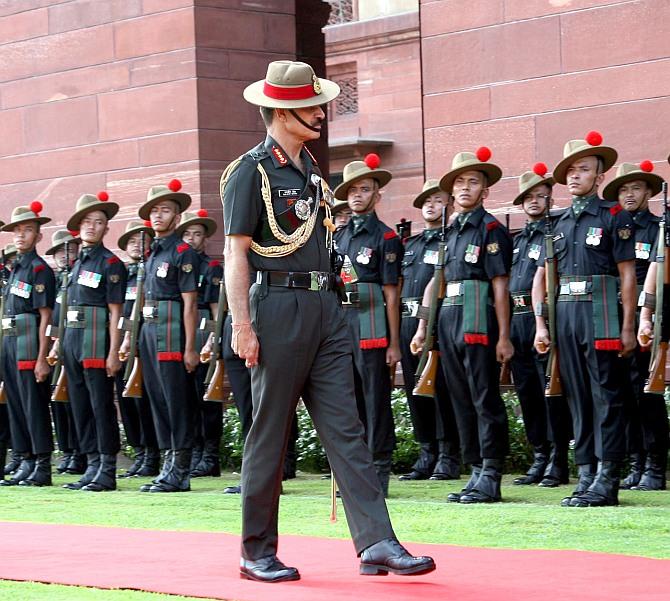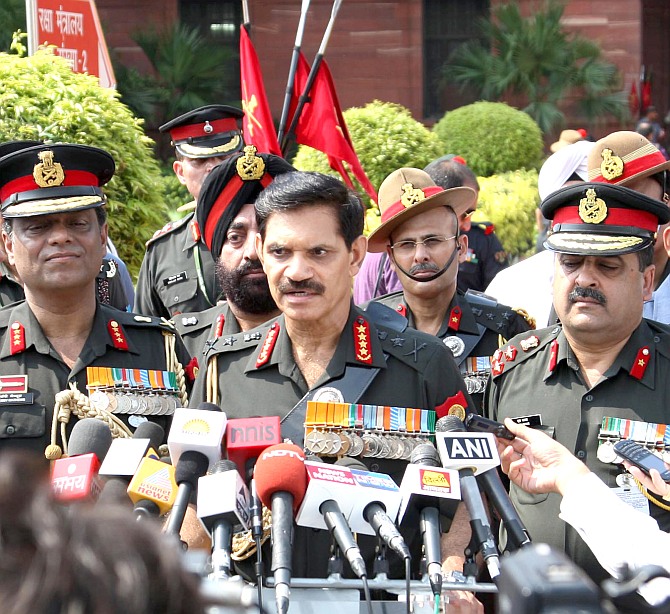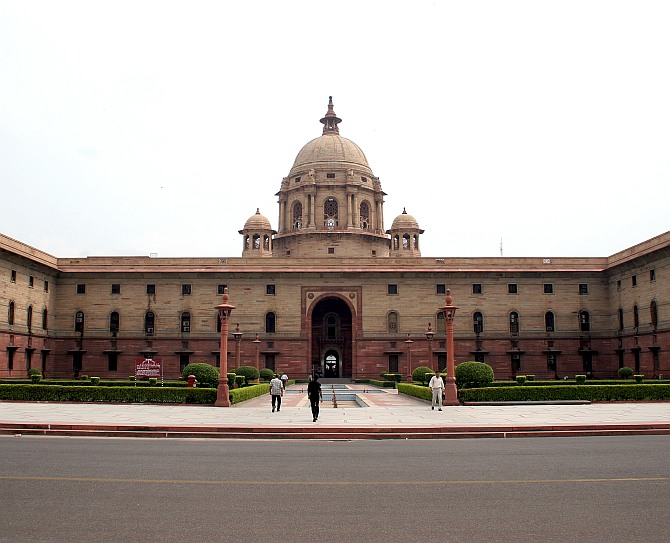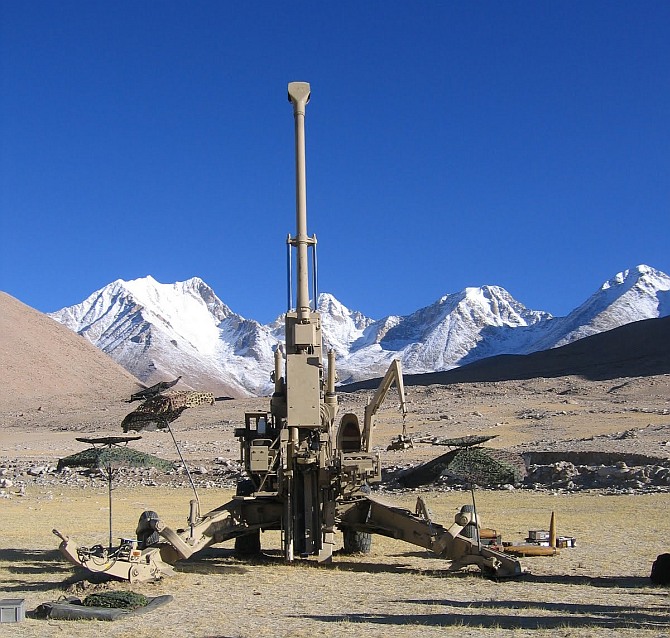 | « Back to article | Print this article |
A manifesto for General Suhag
Tired jargon does not portend transformative change. The new army chief needs to focus, says Ajai Shukla
General Dalbir Singh Suhag, India's 26th army chief, takes over at a time of change and challenge.
As the Chief of Army Staff, Suhag will oversee warfighting and peacetime operations by 1.2 million soldiers, while also supervising the staff work (or coordination) that keeps this force running.
Additionally, he will guide long-term force and equipment structuring and, due to the regrettable absence of a tri-service commander, coordinate with the Navy and Air Force chiefs.
Like many of his predecessors, General Suhag could find himself mired in the sheer vastness of his responsibilities; in the pageantry that is an essential, but time-consuming, part of military life; and in the heady intoxication of command.
Alternatively, General Suhag could create a tangible legacy by focusing, laser-like, on just three critical issues, leaving routine matters to his subordinates.
So far, the new chief's utterances do not promise a new direction.
Please click NEXT to read further...
For More Defence News, CLICK HERE
End military-ministry friction
While assuming command, General Suhag identified his priority as "operational preparedness", especially "force modernisation, infrastructure development, optimisation of human resources [and] welfare of serving personnel and ex-servicemen".
Most chiefs before him espoused similar intentions, to little avail. Tired jargon does not portend transformative change. The new chief needs to focus.
General Suhag's first priority should be two crucial relationships that show worrying signs of stress.
The first is the increasingly antagonistic relationship between the Army and the defence ministry.
The ministry's sanction is vital for procuring new equipment; logistically sustaining the field force; and sanctioning senior officers' promotions.
Yet military-ministry friction causes endless logjams as questions and answers move back and forth leisurely on files, wasting months on issues that could be settled in a five-minute conversation.
In a well-practised blame game, the military complains bitterly that the generalist bureaucrats lack expertise and understanding.
The ministry, with equal justification, accuses the military of being unable to initiate a proposal in comprehensive and simple terms.
This has been going on for years.
Please click NEXT to read further...
Get soldiers and bureaucrats into the habit of working together
The Kargil Review Committee in 1999 and a Group of Ministers (GoM) in 2001 concluded that the defence ministry needs some military officers, partly to help bureaucrats grasp military-technical issues.
At the same time, bureaucrats need to be posted to army headquarters, to help frame proposals.
With the ministry stonewalling cross-posting, the Army has withdrawn sullenly into its cave, forgetting that it needs the ministry, but it's not so the other way around.
The chief must bypass this impasse.
Smoothening communications with the ministry is fundamental to resolving the Army's most serious problems -- such as its debilitating shortfall of junior officers; flattening the unacceptably steep promotion pyramid; enhancing foreign cooperation and military diplomacy; and indigenising defence equipment.
General Suhag must display the heart to walk across to the defence secretary (technically his junior) and, perhaps over a cup of tea, talk about a new way of doing business where ministry officials regularly sit with their functional counterparts from Army headquarters and resolve issues quickly and cordially.
Getting soldiers and bureaucrats into the habit of working together might even whittle away resistance to the integrated defence ministry visualised by the KRC and the GoM.
Please click NEXT to read further...
Fix the vital bond between officers and soldiers
The other relationship that General Suhag must fix is the vital bond between officers and soldiers. That there is discontent in the rank and file is evident from recent uprisings and fratricides.
Elaborate theories about the cause -- failure of local leadership, soldiers' changing sociological profiles and expectations -- may all have a germ of truth.
Yet perceptive commanders agree that the fundamental cause of discontent is the devaluation of military training.
Training is central to morale and professional pride; a well-trained soldier is almost invariably a happy one.
Unfortunately, the Army has disrespected this aspiration, misusing soldiers for duties unconnected with soldiering.
When a havildar (sergeant) who has wasted his three-year peace tenure tending a golf course suddenly finds himself leading a patrol 300 metres from the Line of Control trouble is inevitable.
By refocusing on training, General Suhag will not just raise morale, but also strengthen the operational foundations of the Army.
Please click NEXT to read further...
Push the procurement of weapons platforms
The chief's second thrust area should involve pushing the procurement of three weapons platforms that he deems crucial for battlefield power.
True, the Army already has procurement mechanisms. Yet particularly serious equipment voids demand the chief's personal oversight. The first of these is artillery guns, a battle-winning weapon that has been delayed by decades.
The chief must ensure that guns are inducted through import, as well as indigenous production. The second major equipment void is night-vision devices, without which the infantry soldier -- the Army's fundamental warfighter -- is hamstrung both in counter-insurgency and in war.
The enormous numbers required can only be afforded through technology import and indigenous production, preferably through the private sector.
Third, the chief must personally drive ammunition purchase to make up the Army's wartime stock. With current stocks enough for barely two weeks of fighting, the cabinet has sanctioned the import of Rs 19,000-crore worth of ammunition.
Without this, as the chief knows, the Army is unfit for war.
Please click NEXT to read further...
Build public awareness about the Army
Finally, the chief must drive the building of public awareness about the Army.
Although survey after survey names the Army as India's most admired institution, people have only hazy notions about what these superheroes do.
The result: the Army seldom features in the career options of youngsters who could well make excellent soldiers.
General Suhag must despatch specially selected officers and soldiers to deliver motivational talks and presentations at schools and colleges in areas the Army would like to draw from.
Ironically, few organisations realise the value of human resources as instinctively as the Army; and none do so little to consciously attract these.
(Tailpiece: I am giving a talk on life in the military to Class XII students at one of Delhi's most reputed schools this month. If even one boy or girl in the audience decides to don the uniform, it would be a day well spent.)






